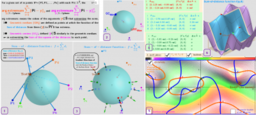Contenuti
Extended definitions of point location estimates
There is a system of n points in 3-D space. For the "overall average" -characteristic of this points, two point estimates of the location are usually used: the geometric median and the geometric center (or center of mass, centroid). In the first case, it is a point that minimizes the function of the sum of the distances to a set of n points -Center of Minimum Distance (for three points, this is the Fermat point), and the sum of the squared distances -in the second case.
I propose a more extended interpretation of the definitions of these two point estimates of the location of a discrete set of n points. These estimates are made, e.g. not in ℝ³, but on a restricted domain. That is, you need to find points in this domain that extremize the function of the sum of the distances (or squared distances) to all points of set.
In applets, a limited number of particles from ℝ³ are considered, and a circle and a sphere are considered as such a domain, i.e. point estimates are sought on a circle / sphere. The search for point estimates on a circle allows you to understand their meaning more clearly . Thus, the search for point estimates is reduced to finding the critical points of the distance sum function f (x, y, z) subject to a constraining equation g(x,y)=x²+y -R² in the case of estimation on a circle or g(x,y,z)=x²+y²+z²-R²-in the case of estimation on the sphere. The problem is solved using Lagrange multipliers. There is a system of equations: ∇f(x,y,z)= λ∇g(x,y,z). A local optimum occurs when ∇f(x,y,z) and ∇g(x,y,z) are parallel, and so ∇f is some multiple of ∇g.
Algorithms are proposed for finding points corresponding to extremes: minima, maxima, and, in the case of the sphere, also saddle points of the sum of distances function.
From: List of My Public Books on GeoGebra Topics: Constructing polyhedra -https://www.geogebra.org/m/eabstecp

Sommario
☛1. Key points in images. ☐
- An Extended Interpretation of the Concept of point estimators of location (geometric medians and geometric centers) in bounded closed domains for a discrete set of points from ℝ³
- List of My Public Books on GeoGebra Topics: Extended Definitions of Point Location Estimates - Geometric Median and Geometric Center
☛2. Estimators of location on a circle/sphere. ☐
- Point estimators of location (Geometric median and Geometric center) of a discrete set of sample points from ℝ³.
- Example of Point estimators of location (geometric medians and geometric centers) defined in bounded closed domain(circle) for a discrete set of points from ℝ³
- Example of Point estimators of location (geometric medians) on a sphere for a discrete set of points from ℝ³
- Description. Geometric Medians on a Sphere.
- Generating two different uniformly distributed points on a sphere using one uniform distribution: Icosahedron V=12.
- Images to applet: Generating two different uniformly distributed points on a sphere from another uniform distribution.
☛3. Optimal position of the" repulsive " set of particles on the circle/sphere. ☐
- ₊Method of Lagrange multipliers. Relative positioning of "repulsive" movable points on a circle
- ₊Finding the optimal relative position of the" repulsive " set of particles on the circle
- Method of Lagrange multipliers. Placing points on a circle/sphere such that the each point is the geometric median of all its other points.
- ₊Finding the optimal relative position of the" repulsive " set of particles on the sphere
- 1. The problem of extreme distribution of points on the surface of a sphere.
- Some cases of polyhedra with an extreme distribution of their vertices on the surface of a sphere.
- Installation of extreme distributions of the vertices of the polyhedra Cube, Gyrobifastigium, Dodecahedron by fixing their two antipodal vertices.
- Polyhedra whose vertices are equivalent and have an extreme distribution on the same sphere.
- Example of non-uniqueness of the extreme distribution of n=16 particles on the surface of a sphere.
- 3d shapes: n=72. Extreme distribution of points on the surface of a sphere and comparison with two known but not extreme ones having the same number of vertices
- Images. Placing points on a sphere such that the each point is the geometric median of all its other points.
- Dependence of the maximum of the sum of the mutual distances of points on the sphere on their number.